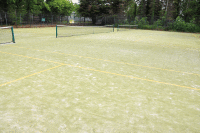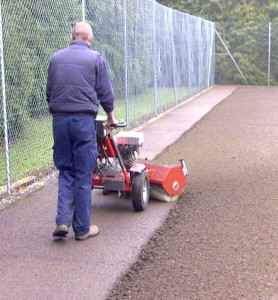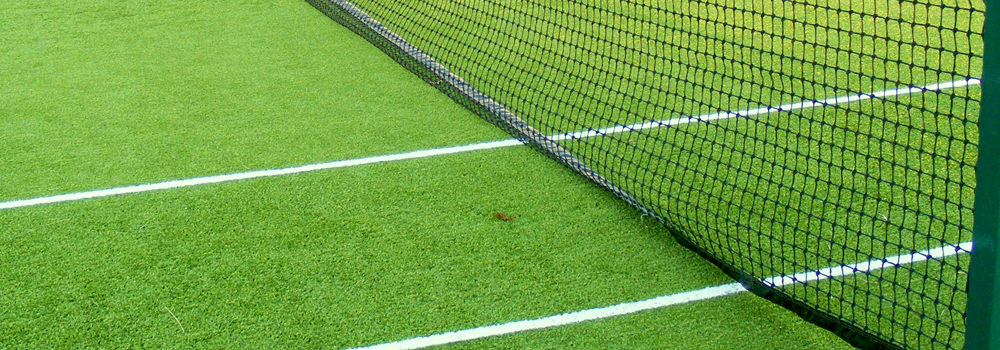
Use the artificial courts, providing they are safe and free from algae and/or moss.
Key Tasks for January

Keep off, unless there is a significant change in temperature and improvement in the weather. Should this happen, then the following can be undertaken:
- maintain a height of cut between 12-18mm
- a cylinder mower may still be used, but it is more likely that a rotary mower will serve you better
- box clippings to avoid the spread of disease
- remove leaves and other debris as soon as possible – a rotary mower does a good job
Artificial courts
Keep surface clean with regular sweeping and brushing
Remove any algae and moss from surface. Sand filled systems require regular brushing to maintain manufacturer’s recommendations on sand levels and pile heights
American Fast Dry courts
- keep surface clean, rolling to consolidate surface
- levelling and brushing of fast dry materials, brushing to clean lines
Clay courts
- carry out regular sweeping and brushing to restore playing levels
- topdress any hollows or damaged areas
Tarmacadam
- carry out regular sweeping and brushing
- repair any hollows or damaged areas
With many clubs allowing and, indeed encouraging, play on their artificial surfaces through the winters months (when weather conditions allow), it is imperative that these courts are completely free from moss, algae, leaves or anything else that might pose a slip hazard.




The plant will require a small quantity of nitrogen during any warmer periods; anyone who applied a slow release fertiliser in late October or November should still have some residual longevity to draw from. If conventional release fertilisers were used, then the 4-6 weeks longevity will be coming to an end. In this instance, it is vital to keep a close eye on turf for any signs of yellowing and lack of vitality. Applying a granular turf hardener, with an NPK analysis close to 4-0-4, will be suitable. Alternatively, a soluble fertiliser with some nitrate will also be useful in maintaining health.
Iron will continue to be an important micro nutrient to apply when looking to help guard against fungal disease pathogens by thickening plant cell walls. Calcium and phosphite are also important nutrients which can be applied as liquid sprays for this purpose.
With cold conditions forecast, then a similar principle can be applied with the same plant elements. In this instance, they work to help the plant tolerate the stresses and strains of frost and harsh desiccating winds. A granular slow release iron such as Maxwell Bullet Duragreen is a very sensible solution for providing a nice steady trickle of iron for up to three months.
Consider also applications of Magnesium along with iron, which as a key component of chlorophyll will help to maximise photosynthesis on long dark days.

As always, removing dews daily and avoiding nutritional stress are vital cultural controls. A contact fungicide containing Iprodione can be applied as protection when disease is active but, with any fungicide, early identification and action are absolutely crucial in achieving the best results.
If snow is forecast, then applying Iprodione to surfaces in advance will guard against disease spreading under a nice damp insulated blanket.
A sensible strategy to employ between outbreaks of disease is to apply a fungicide containing Fludioxonil. This active ingredient will attack fungal disease spores as they lie in wait for suitable weather conations to mount an attack. Fludioxonil disrupts the regulation of osmosis (osmoregulation) and results in the disease pathogen cells rapidly absorbing water to such a point that their cell walls can no longer maintain rigidity and explode, therefore nullifying the threat.
If your spraying equipment has not been checked for calibration and nozzle quality, then it is an operation worth undertaking as 10-20% of fungicide efficacy is reliant on the quality of the spray operation. Another way to look at this is 10-20% of the cost of a fungicide, or any other sprayed product for that matter.
Systemic curative and protective fungicides can be used to control diseases; there are a wide range of products on the market that have the active ingredients Chlorothalonil and Iprodione. These fungicides are usually applied in liquid form using water as a carrier. All personnel should be suitably qualified in the application of chemicals.
Worm activity can be quite prevalent during the winter months, especially during periods of mild weather. Keep an eye on the square and treat accordingly. Worm treatments can be carried out if needed, but please remember to ask yourself why worms are present. pH levels, organic matter and your cultural practices on the square need to be assessed. Carbendazim is now the only active ingredient available for controlling worms.
With pests such as rabbits, foxes and moles it a case of identifying the problem and controlling their activities; employing approved pest control services to eradicate them from site may be a solution.
The combination of early morning dews, warm and wet weather and diminishing daylight hours increases the risk of fungal disease outbreaks. The right conditions to trigger these disease attacks are weakened or susceptible plants, a disease-producing organism (pathogen usually fungi) and weather conditions which favour the formation of fruiting bodies and spores (moist, mild wet conditions).
The typical types of diseases you may come across this time of year are:
- Fusarium Patch
- Red Thread
- Dollar Spot
Please note: More information on these and many others can be found here: https://www.pitchcare.com/useful/diseases.php
With some machines not currently being used, take the time to carry out an overhaul or send them away for a service.
- inspect and clean machinery before putting away for the winter
- replace worn and damaged parts as necessary
- empty fuel tanks as petrol will go stale over winter
- maintain a stock of consumables for your machinery
- secure machinery nightly with good storage facilities and strong locks
- record makes and models and take pictures of your equipment as additional reference
- don’t leave it to the last minute when servicing dealers will be very busy

Some of the courses available are:
- Chainsaws - CS30 and CS31
- H&S Refresher Training on Combined Turf Care Equipment; Tractors and Trailers; All Mowers (Ride-on and Pedestrian)
- Machinery Courses on ATVs; Tractors: Brushcutters/Strimmers; Mowers (ride-on and Pedestrian)
- Pesticide Application (PA courses)
- Stem Injection of Invasive Species (Japanese Knotweed etc.)
- Basic Trees Survey and Inspection
More details about all the courses can be found here, or you can email Chris Johnson for information.
Other Key Tasks
- repair and maintain fence lines
- cut back any hedges and trees and prune shrubs
- take down and store all tennis equipment, ensuring that it is clean and dry before doing so
- repair/update equipment as necessary
Whilst many of the above actions may appear to be common sense, it is surprising how some things can get overlooked, often due to the lack of daylight hours. The more that club members, players and officials understand what you role involves, the better. You could use any spare time to provide a members newsletter/blog detailing what problems you are experiencing (disease outbreaks, algae and moss, waterlogging etc.) and to seek additional help as required
Articles you may find helpful
https://www.pitchcare.com/magazine/refurbishing-existing-surfaces.html
https://www.pitchcare.com/magazine/synthetic-tennis-courts-dealing-with-migration.html
https://www.pitchcare.com/magazine/busy-time-at-the-priory.html
https://www.pitchcare.com/magazine/walmer-tennis-club-racquet-mallet-and-renovation.html
https://www.pitchcare.com/magazine/hard-surface-tennis-courts-take-them-seriously.html
https://www.pitchcare.com/magazine/a-game-to-love-but-is-grass-losing-it.html


